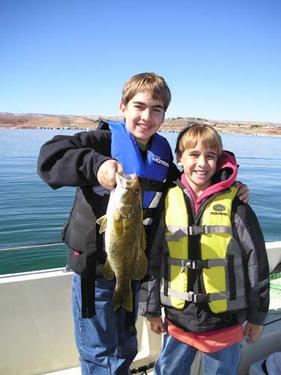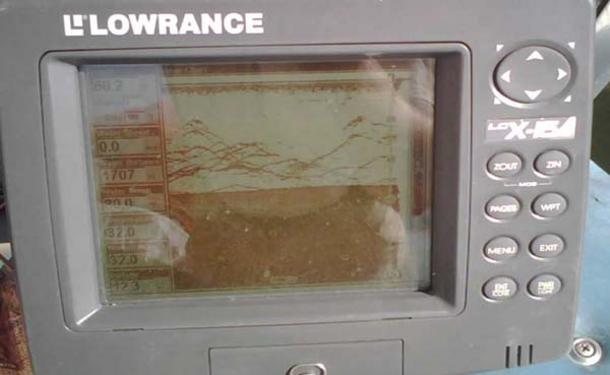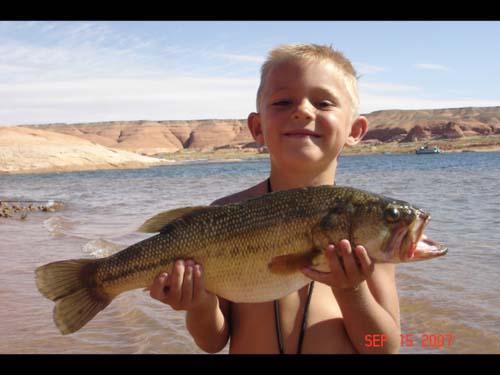Long Range Fish Report
From Sportfishing
From Sportfishing
Fish Report for 10-16-2007

Lake Powell Fish Report 10-16-07
10-16-2007
Wayne Gustaveson
Fishing at Lake Powell is still hot - but only in the inflow areas from Red Canyon to Hite and in the upper reaches of San Juan's Great Bend. Stripers have chased shad to the ends of the lake where the highest numbers of forage fish now reside. In these isolated locations boils continue on most days. Spooning at depths of 40-60 feet is a sure thing where the graph shows schools of fish. If looking for the greatest chance of fishing success, head to the inflowing waters of the Colorado and San Juan Rivers.
In the main lake fishing is spotty with decent catches one day followed by sight-seeing the next. Stripers are moving toward the backs of the canyons but with cooler temperatures there are many more time periods when no feeding is done. Some may not realize that stripers prefer to feed at night. When fishing is tough during the day and fish are seen on the graph, the best way to get them to respond is by night fishing.
A green or white light attracts and congregates plankton. The plankton swarm soon gets the attention of small forage or game fish. Small schooling fish then attract stripers. October and November may be the best months for night fishing. Water is not cold enough to shut down the feeding response and fish that choose to eat at night are very susceptible to feeding near the lights. To catch stripers, fish anchovy bait deeper than the lighted shad school, usually 30-60 feet. Again, fishing near the inflow areas is better than main lake areas where striper schools are scattered.
Fishing for bass is a better bet in the main lake. Temperatures in the low 60's are ideal for large and smallmouth bass. The current temperatures coincide with highest bass activity in spring time. Standard bottom bouncing techniques with dark green plastic baits is very effective. Bass are still eating as much as possible as they prepare for a long winter of inactivity. Look near weed beds and brush structures for the best success. Structure at 15 to 25 feet may be the best target area to catch some of the biggest bass of the year. Bass caught in 2007 have had the largest average size since 1996.
Another bonus at this time and temperature is the resurgence of crappie. Schools are difficult to find but once located they don't move much so many can be taken at one spot. Remember the 10 fish crappie limit.
Catfish and walleye are likely to provide some interesting action at times. It is getting late in the season but fishing is not done for the year.
In the main lake fishing is spotty with decent catches one day followed by sight-seeing the next. Stripers are moving toward the backs of the canyons but with cooler temperatures there are many more time periods when no feeding is done. Some may not realize that stripers prefer to feed at night. When fishing is tough during the day and fish are seen on the graph, the best way to get them to respond is by night fishing.
A green or white light attracts and congregates plankton. The plankton swarm soon gets the attention of small forage or game fish. Small schooling fish then attract stripers. October and November may be the best months for night fishing. Water is not cold enough to shut down the feeding response and fish that choose to eat at night are very susceptible to feeding near the lights. To catch stripers, fish anchovy bait deeper than the lighted shad school, usually 30-60 feet. Again, fishing near the inflow areas is better than main lake areas where striper schools are scattered.
Fishing for bass is a better bet in the main lake. Temperatures in the low 60's are ideal for large and smallmouth bass. The current temperatures coincide with highest bass activity in spring time. Standard bottom bouncing techniques with dark green plastic baits is very effective. Bass are still eating as much as possible as they prepare for a long winter of inactivity. Look near weed beds and brush structures for the best success. Structure at 15 to 25 feet may be the best target area to catch some of the biggest bass of the year. Bass caught in 2007 have had the largest average size since 1996.
Another bonus at this time and temperature is the resurgence of crappie. Schools are difficult to find but once located they don't move much so many can be taken at one spot. Remember the 10 fish crappie limit.
Catfish and walleye are likely to provide some interesting action at times. It is getting late in the season but fishing is not done for the year.
< Previous Report Next Report >
More Reports
Lake Powell Fish Report 09-26-07
Lake Powell
9-26-2007
Details of this report will include general concepts that will work through mid October. I will be on vacation for...... Read More
Lake Powell Fish Report 09-19-07
Lake Powell
9-19-2007
After months of water temperatures in the 80's significant cooing has dropped surface temperature to 75. That's a very active...... Read More

LongRangeSportfishing.net © 2025. All Rights Reserved.
Website Hosting and Design provided by TECK.net
Website Hosting and Design provided by TECK.net